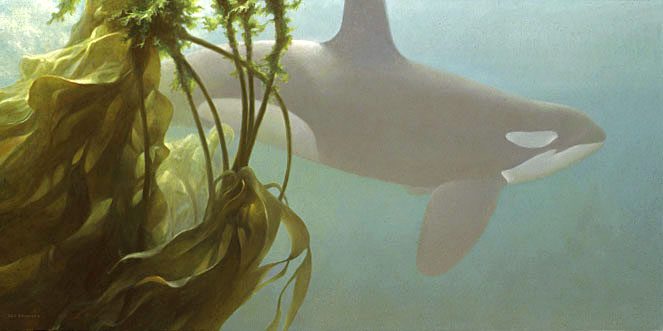
Like wolves, killer whales have a special place in the hearts and imaginations of humans. Deep down we may realize the kinship. Although we belong to three different types of mammals, wolves, whales and humans have evolved as killers. We can be completely ruthless with other species in order to provide food for ourselves. Unlike humans, wolves and whales seldom kill their own kind. We three species are social animals that are very intelligent, communicative, teach our young and have complex family attachments and group activities. The big mystery to me is that in spite of our abuse and threats to wolves and whales, they have almost never picked on us. They could kill us easily but they evidently don't want to hurt us.
Another damaging thing we as a species are doing to killer whales is over-fishing. In large areas of Alaska where sea otters have been most abundant, their numbers are plummeting. Between the 1970's and 1990's otter numbers dropped from 53,000 to 6,000! This is because the seals and sea lions, an important prey of the killer whales are running out of fish and their numbers are in steep decline. Killer whales, being intelligent, opportunistic creatures have changed their hunting habits to prey on sea otters that formerly were so small as to be snack food. With sea otters getting scarcer, sea urchin populations are booming. Sea urchins eat kelp, particularly the holdfasts that fasten the great kelp beds to the sea floor. This means that kelp 'forests' are being depleted which takes away sea otter shelter and makes them more vulnerable to killer whales.
The kelp forests are also important breeding grounds and shelter for marine fishes. This, in turn, exacerbates the problem of over-fishing. Nature is not only more important than we know, it is more important than we can know. We make major changes in it at our peril!
I live on the Pacific coast with its mighty forests of Douglas fir, red cedar, hemlock and other trees. However, equally close to our house is a forest of another kind. This is the mighty kelp forest (Nereocystis luetkeana - 10' to 100' in length, edible). From my studio I can see, just breaking the surface, the floating bulbs of the bull kelp. When some is broken loose in a storm and washed ashore, it looks like great, translucent, tapered, amber plastic tubes, yards long, with a bulbous end mounted with very long, wavy fronds. High and dry they look sad and stranded but under water they are visually among the most exciting plants in the world, not to mention one of the largest seaweeds. They wave and undulate in constantly changing patterns like a kaleidoscope. The sun glows through them so it seems they are lit from within. They are always graceful. Their rhythms immediately bring to mind masterpieces of 'art nouveau'. I have snorkeled and scuba-dived through and around these kelp forests. It is always as visually thrilling as a visit to an art museum.
This is why I have featured the bull kelp with its subsurface epiphyte in this painting. It is an important and overlooked natural world and it is beautiful. In the hazy distance a killer whale swims by. Although I have not actually seen this while scuba diving, the hairs stand up at the back of my head at the thought of it.